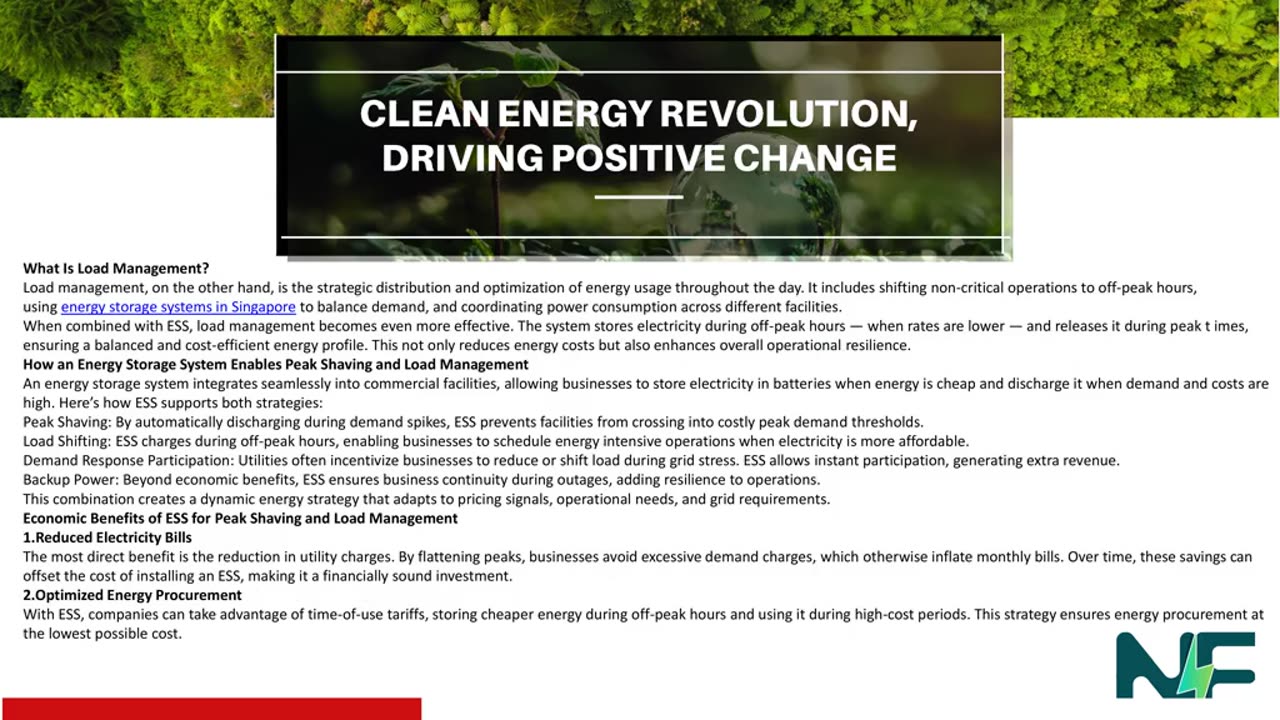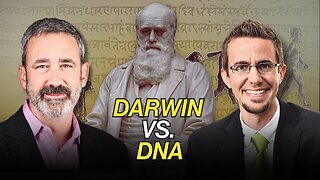Premium Only Content

Peak Shaving and Load Management: Unleashing the Economic Benefits of Commercial ESS — Neg Power
Commercial and industrial businesses are under increasing pressure to optimize operational costs, improve efficiency, and meet sustainability goals. Among the most transformative technologies enabling this shift is the energy storage system (ESS). By combining peak shaving and load management strategies, an energy storage system empowers businesses to unlock significant economic advantages while also contributing to grid stability and environmental stewardship.
This article explores how commercial ESS supports peak shaving and load management, why these strategies are vital in the modern energy market, and the far-reaching financial benefits businesses can achieve by adopting them.
Understanding the Challenge: Rising Energy Costs
Electricity pricing is not static; it fluctuates throughout the day based on demand. During peak demand hours — often in the late afternoon or early evening when offices, factories, and households all consume energy simultaneously — utilities charge significantly higher rates. This cost spike is known as peak demand charges.
For commercial and industrial facilities, these charges can account for up to 30–50% of their total electricity bills. Traditional methods to reduce costs, such as cutting back operations or running backup generators, are either disruptive or environmentally harmful. A more strategic and sustainable solution is required — and that is where the energy storage system comes in.
What Is Peak Shaving?
Peak shaving refers to the practice of reducing electricity consumption during periods of highest demand. Instead of drawing expensive power from the grid, businesses use stored energy from their energy storage system during peak hours. By doing so, they “shave off” the peaks in their load profile, thereby reducing demand charges.
For example, a factory that experiences a production surge in the afternoon can rely on its ESS to supplement grid electricity. This lowers the peak load, ensures smooth operations, and significantly reduces costs without requiring production downtime.
What Is Load Management?
Load management, on the other hand, is the strategic distribution and optimization of energy usage throughout the day. It includes shifting non-critical operations to off-peak hours, using energy storage systems in Singapore to balance demand, and coordinating power consumption across different facilities.
When combined with ESS, load management becomes even more effective. The system stores electricity during off-peak hours — when rates are lower — and releases it during peak t imes, ensuring a balanced and cost-efficient energy profile. This not only reduces energy costs but also enhances overall operational resilience.
How an Energy Storage System Enables Peak Shaving and Load Management
An energy storage system integrates seamlessly into commercial facilities, allowing businesses to store electricity in batteries when energy is cheap and discharge it when demand and costs are high. Here’s how ESS supports both strategies:
Peak Shaving: By automatically discharging during demand spikes, ESS prevents facilities from crossing into costly peak demand thresholds.
Load Shifting: ESS charges during off-peak hours, enabling businesses to schedule energy intensive operations when electricity is more affordable.
Demand Response Participation: Utilities often incentivize businesses to reduce or shift load during grid stress. ESS allows instant participation, generating extra revenue.
Backup Power: Beyond economic benefits, ESS ensures business continuity during outages, adding resilience to operations.
This combination creates a dynamic energy strategy that adapts to pricing signals, operational needs, and grid requirements.
Economic Benefits of ESS for Peak Shaving and Load Management
1.Reduced Electricity Bills
The most direct benefit is the reduction in utility charges. By flattening peaks, businesses avoid excessive demand charges, which otherwise inflate monthly bills. Over time, these savings can offset the cost of installing an ESS, making it a financially sound investment.
2.Optimized Energy Procurement
With ESS, companies can take advantage of time-of-use tariffs, storing cheaper energy during off-peak hours and using it during high-cost periods. This strategy ensures energy procurement at the lowest possible cost.
3.Avoided Infrastructure Upgrades
High peak demand often forces businesses to upgrade transformers, switchgear, or distribution systems. By reducing peak loads through ESS, facilities can delay or avoid these expensive infrastructure investments.
4.Enhanced Participation in Energy Markets
In liberalized energy markets, businesses can use ESS for demand response programs or even sell stored energy back to the grid. This transforms the energy storage system into a revenue-generating asset.
5.Improved ROI on Renewable Energy
Commercial buildings that have solar panels or other renewable systems often face intermittency challenges. ESS stores excess renewable generation and releases it when demand is high, increasing self-consumption and reducing reliance on the grid. This improves the return on renewable energy investments.
Case for Sustainability
Beyond economics, adopting ESS for peak shaving and load management aligns with broader sustainability goals. By reducing reliance on fossil-fuel-based peaking plants, businesses indirectly lower carbon emissions. This not only benefits the environment but also strengthens corporate social responsibility (CSR) profiles and aligns with Singapore’s Green Plan 2030 and similar global initiatives.
Moreover, customers and investors increasingly value sustainable practices. A company that demonstrates efficient energy management through ESS gains a competitive advantage in branding and stakeholder trust.
The Role of Advanced Technologies
Today’s ESS is more than just a battery. Integrated with smart energy management software, it offers real-time monitoring, predictive analytics, and automated control. These features ensure maximum savings by precisely timing charge and discharge cycles.
For instance, artificial intelligence can forecast demand patterns based on historical usage and weather data, enabling the energy storage system to optimize its operations proactively. This minimizes human intervention and maximizes economic benefits.
Overcoming Barriers to Adoption
While the benefits of ESS are clear, some businesses hesitate due to upfront costs, perceived complexity, or lack of awareness. Here are strategies to overcome these challenges:
Financing Models: Leasing and pay-as-you-save schemes reduce capital expenditure.
Government Incentives: Many regions, including Singapore, offer subsidies and tax benefits for adopting clean energy technologies.
Scalability: Modern ESS solutions are modular, allowing businesses to start small and expand capacity as needs grow.
Vendor Partnerships: Collaborating with experienced ESS providers ensures smooth installation, operation, and maintenance. By addressing these barriers, companies can transition confidently toward smarter energy management.
Future Outlook: ESS as a Business Standard
As energy markets evolve, the role of ESS in commercial sectors will only expand. The global push for decarbonization, combined with rising electricity costs, positions ESS as a central player in the energy transition.
In the near future, businesses may view an energy storage system not as an optional add-on but as a standard operational requirement — similar to IT infrastructure or HVAC systems today. With continuous advancements in battery technology and falling costs, the economic case for ESS will become even stronger.
Practical Steps for Businesses Considering ESS
Energy Audit: Begin with a detailed analysis of your facility’s load profile to identify peak demand patterns.
Set Objectives: Define whether your goal is cost savings, sustainability, or both.
Engage Experts: Consult an experienced ESS provider to design a solution tailored to your operations.
Pilot Project: Start with a manageable capacity to test performance before scaling up.
Measure and Optimize: Use real-time data to monitor ESS performance and continually refine strategies for maximum impact.
Taking a structured approach ensures businesses maximize both short-term and long-term benefits.
Conclusion: Unlocking the Power of ESS
In an era of rising energy costs and growing sustainability demands, peak shaving and load management are no longer optional strategies — they are essential for competitive advantage. By leveraging a commercial energy storage system, businesses not only reduce electricity bills but also enhance resilience, unlock new revenue streams, and demonstrate environmental leadership.
The economic benefits are clear: lower operational costs, deferred infrastructure upgrades, and maximized returns on renewable energy. Coupled with advanced software and smart integration, ESS empowers companies to navigate energy challenges with confidence. Ultimately, adopting an energy storage system is about more than just savings — it’s about securing a future where businesses thrive economically while contributing to a more sustainable energy ecosystem. For forward-thinking companies, the time to embrace ESS is now.
Pop over here : https://www.negpower.sg/energy-storage-harness/
-
 LIVE
LIVE
The Chris Salcedo Show
11 hours agoGOP Shields Violent Left From Consequences For Their Actions
1,031 watching -
 LIVE
LIVE
Welcome to the Rebellion Podcast
11 hours agoDisney Star Tells People to Cancel Disney - WTTR Podcast Live 9/19
305 watching -
 LIVE
LIVE
Game On!
19 hours ago $0.96 earnedHappy FOOTBALL FRIDAY! Week 3 NFL Betting Preview!
1,158 watching -
 15:10
15:10
Michael Button
15 hours ago $2.35 earnedGroundbreaking Discovery at Giza Pyramids?
44.3K8 -
 18:11
18:11
Tactical Considerations
15 hours ago $1.71 earnedIs This the Best Truck Gun for 2025?
11.9K3 -
 8:37
8:37
The Art of Improvement
20 hours ago $0.71 earnedLife Lessons I’d Tell My Teenage Self
10.5K3 -
 LIVE
LIVE
BEK TV
23 hours agoTrent Loos in the Morning - 9/19/2025
193 watching -
 17:22
17:22
Adam Does Movies
13 hours ago $1.80 earnedIce Road: Vengeance - Movie Review
67K4 -
 45:05
45:05
Uncommon Sense In Current Times
17 hours ago $1.00 earnedDarwin vs. DNA | Dr. Nathaniel Jeanson on Creation Science, Evolution & the Case for Genesis
18.6K3 -
 32:19
32:19
The Lou Holtz Show
14 hours agoThe Lou Holtz Show S2 EP18 | Danica Patrick on Fearlessness, Faith & Finding Purpose #podcast
17.2K4